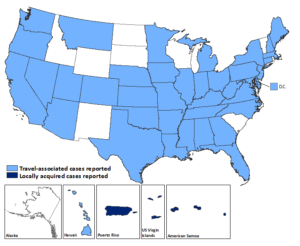Like the Killer Bees, the Aedes mosquitoes carrying the Zika Virus have spread across the southern part of the U.S. and are steadily expanding northward.
But people travel much faster than mosquitoes, and so the disease has outpaced the mosquitoes.  Here’s a Center for Disease Control map (from April, 2016) showing where cases of the disease occur. UPDATE from December, 2016. Every state in the U.S. now has reported infections — a total of 4,756 in all!
Here’s a Center for Disease Control map (from April, 2016) showing where cases of the disease occur. UPDATE from December, 2016. Every state in the U.S. now has reported infections — a total of 4,756 in all!
So far, most of these illnesses are travel-associated.
But it is only a matter of time before the mosquitoes get here. In fact, because symptoms of the disease are typically mild and like those of a lot of other diseases, the mosquitoes may already be here and we just don’t know it because infections haven’t been reported.
Symptoms: fever, rash, joint pain and red eyes (conjunctivitis). People don’t get sick enough to go to a hospital, and rarely die. The concern, as we know, is for pregnant women, whose unborn babies may be affected.
So how to avoid bites from disease-carrying mosquitoes?
No matter where you live, or how old you are, here are three important steps to take to protect yourself and your family.
1 – Get rid of standing water!
It’s simple. Mosquitoes lay eggs in water, the eggs hatch, and you have bugs. So take a tour around your home and office and clean up or get rid of any standing water. In particular, look for . . .
- Water barrels and recycle bins
- Flower pots, saucers, toys
- Areas around drains
- Old tires
- Pet or animal water bowls
- Bird bath
2 – Wear long-sleeved shirts and long pants.
Mosquitoes are particularly active for an hour before and after dawn and dusk. Cover up and, if necessary, go inside to avoid getting bit.
3 – Use insect repellents.
We’ve probably all experienced that slippery smelly stuff that we slathered on as kids. It worked, but wasn’t very comfortable.
From what I can tell, things have improved somewhat. Here are some of the decisions you’ll want to make before buying any insect repellent.
- What insects do you want to repel? We’re talking here at Emergency Plan Guide about mosquitoes, but some repellents are good for ticks, chiggers, etc. as well. Read the labels.
- Do you want to use DEET? DEET (N,N-Diethyl-meta-toluamide, or diethyltoluamide), developed in the 1940s for use by the army, is the (yellow) chemical ingredient that is the standard for repellents. Tests show that the higher the concentration, the longer the protection. (For example, 100% DEET was found to offer up to 12 hours of protection while several lower concentration DEET formulations (20%-34%) offered 3–6 hours of protection.) Most of what I read suggests that non-DEET repellents shouldn’t be relied on for prolonged protection where mosquito-borne diseases are a substantial threat.
- How long do you need protection? Note the concentration and buy and re-apply accordingly. Labels are very clear as to the percentage concentration, and will give you an idea of how long to expect the repellent to last.
- Three chemical alternatives to DEET are Picaridin, Permethrin and IR3535. They don’t seem to affect plastic or vinyl the way DEET does, and have similar protective capabilities. Again, check percentage concentrations.
- Looking for a natural repellent? Consider Oil of Lemon Eucalyptus. It seems to provide good protection with a pleasant odor (!) but protection may not be as long lasting as the chemical repellents.
All these repellents come in lotion, cream or pump, and some as wipes.
Note for children: Some repellents come as the ingredient in a “repellent bracelet,” but reviews suggest these bracelets may not be as effective as advertised. In any case, if you have children, be sure to note age restrictions that appear on some of these products.
What do repellents cost?
With all that info behind us, let’s move on to the good news.
Repellents are easy to get and quite inexpensive — less than $10.
There is no reason not to have a bottle or two handy in the car and in the house as part of your personal program to prevent the spread of disease.
Some recommendations for repellents.
These can be readily found at drugstores; clicking the link will take you to Amazon, where you’ll find a lot of detail and reviews from users, which I find particularly useful.
A DEET product at 98.1% concentration: Repel 100 Insect Repellent, 4 oz. Pump Spray, Single Bottle
Up to 10 hours of protection. Comes in a pump bottle small enough to carry easily.
From the same company, a natural ingredient formula: Repel Lemon Eucalyptus Natural Insect Repellent, 4-Ounce Pump Spray
This product is advertised as having a “cool, refreshing scent”. Up to 6 hours of protection.
Another version of repellent designed to be sprayed on outdoor clothing: Sawyer Products Premium Permethrin Clothing Insect Repellent Trigger Spray, 12-Ounce
This is advertised as being “as effective as 100% DEET.” Spray it on clothing, it won’t stain or damage, and will last through multiple washings.
My recommendation — Don’t wait until you read that the virus has hit YOUR town. Clean up your yard, then get and start using insect repellent. Pretty simple precautions.
Virginia
Your Emergency Plan Guide Team
A note: We’ve talked about mosquitoes carrying the virus. Be aware that it can also be transmitted through sex. If someone is infected, abstinence is the best protection.
Don't miss a single Advisory.
Thank you for subscribing.
Something went wrong.
